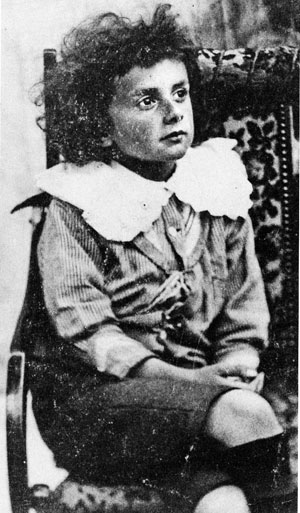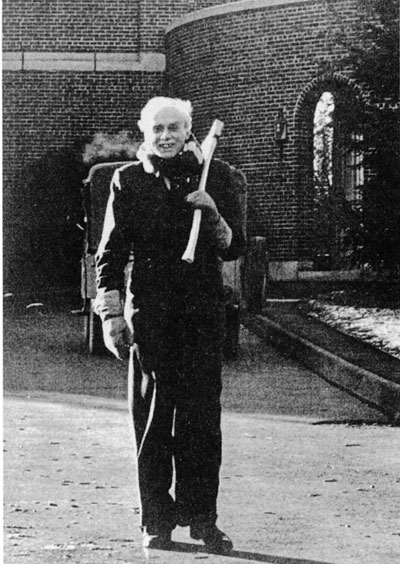
This Article From Issue
November-December 2009
Volume 97, Number 6
Page 502
DOI: 10.1511/2009.81.502
THE STRANGEST MAN: The Hidden Life of Paul Dirac, Mystic of the Atom. Graham Farmelo. x + 539 pp. Basic Books, 2009. $29.95.
Paul Adrien Maurice Dirac (1902–1984) might be one of the best subjects imaginable for a scientific biography. He is also surely one of the worst. In most scientific biographies, presenting the life is easy, but integrating the scientific work proves a struggle. For Dirac, the polarities are reversed. His accomplishments in theoretical physics provide a natural narrative. His life, however, was disjointed, chaotic and almost surreal in its juxtaposition of incongruous elements. In The Strangest Man, Graham Farmelo offers a highly readable and sympathetic biography of the taciturn British physicist who can be said, with little exaggeration, to have invented modern theoretical physics. The book is a real achievement, alternately gripping and illuminating, and the few flaws in the biographical integration are often due to the recalcitrance of the subject himself.
It would have been far easier to tackle only the physics, and surely that would have been enough. Dirac’s life spanned most of the 20th century, and he was at the core of its decisive scientific revolution: quantum mechanics. “At the core” is an understatement. As Farmelo sagaciously puts it,
In his heyday, between 1925 and 1933, he brought a uniquely clear vision to the development of a new branch of science: the book of nature often seemed to be open in front of him.
Dirac’s contribution to physical theory was legendary even before he turned 30: He was appointed to the Lucasian Chair of Mathematics at Cambridge in 1932, becoming the most distinguished holder of that honor since Isaac Newton (it is now occupied by Stephen Hawking). The following year, Dirac became the youngest theorist to win a Nobel Prize in physics. It had been a short rise to the top. Only in 1926 had Dirac submitted his dissertation, titled “Quantum Mechanics” (the first ever written on the subject), to the University of Cambridge. After that he seemed to be on a single-minded mission to recreate the universe. The reader will be stunned as one staggering insight after another is described—the Dirac equation, the prediction of antimatter, the cosmological speculations, his forays in the 1950s into “strings” instead of point particles, his postulation of a magnetic monopole, and so on. In the case of nearly every exciting new theory of modern physics, Dirac appears to have gotten there first. Richard Feynman, no slouch himself, eventually became famous for expanding quantum mechanics further, and afterward would sometimes quip, “I don’t know what all the fuss is about—Dirac did it all before me.”
But it was not simply that Dirac made a number of important developments in quantum theory. The manner in which he developed quantum mechanics bore a characteristic stamp—a style—that helped determine the nature of theoretical physics. Dirac’s style demands a biographical treatment, so that we can see how all the disparate pieces fit together. Forget that his “bra-ket” notation for representing complex state vectors is now ubiquitous in quantum mechanics, and ignore for the moment the “Dirac delta function” that he incorporated into the structure of field theory. The point is more general. This highly abstract, exquisitely mathematical presentation of physics became part of what it was to be a theoretical physicist. Being a theoretician came to mean asymptotically approaching (but never quite reaching) the standard set by Dirac. Farmelo manages with scarcely an equation to capture the beauty and ambition of this worldview, and he takes us a considerable way toward understanding how Dirac’s version of quantum mechanics became everyone’s version of quantum mechanics. That is one great story, and the reader will become nearly as engrossed in Farmelo’s telling of it as Dirac was in living it.
Living the physics was comparatively easy; living as Paul Dirac was rather more trying. A number of “Dirac stories” circulate as lore within the scientific community. In contrast to the myriad anecdotes about Feynman, Dirac’s stories were not self-fashioned, and he seemed oblivious to the rather peculiar figure he cut. For example, when visiting a Copenhagen art gallery with his lifelong mentor, Niels Bohr, who was the grand architect of the quantum worldview, Dirac observed of one impressionist painting: “This boat looks as if it was not finished.” And a bit later, of a different canvas: “I like that because the degree of inaccuracy is the same all over.” These sentences count as veritable orations coming from Dirac, who seemed happiest sitting in silence, discouraging attempts at casual conversation with monosyllabic retorts.
His literal-mindedness entered the classroom as well. During a lecture at the University of Wisconsin, Dirac asked the room whether there were any questions. An audience member called out: “I don’t understand the equation on the top-right-hand corner of the blackboard.” Minutes passed, while Dirac stood impassively. When prompted by the discomfited moderator for a reply, Dirac stated: “That was not a question, it was a comment.” The humorous accounts of Dirac’s general oddity pepper physicists’ recollections of him and led Bohr to dub him “the strangest man.”
These stories are part of the reason that reading this biography is so much fun, but they also represent Farmelo’s greatest challenge. How do you write an accurate life of a man who accumulated this much mythology over the decades (some of it surely invented or distorted), and yet was so taciturn about his internal states that you have no obvious way to correct the myths? Farmelo handles this dilemma masterfully, entertaining us with the stories and simultaneously sifting the wheat from the chaff, such as when he notes that many of Werner Heisenberg’s accounts of incidents involving Dirac in the 1920s are “implausibly detailed.”
What we get is an odd picture, almost a cubist portrait of different features of Dirac that somehow add up to something that is both less than and more than a man. On the one hand, this person could spend weeks on end working on complicated physics, his work interrupted only by exhaustingly long walks in the British, Danish, Russian or American countryside. (Dirac proved rather cosmopolitan, and the discussions of his affection for the “Soviet experiment” and especially for physicist Peter Kapitza are very apt, even though they do not approach the delicate sensitivity with which Farmelo dissects British academia. And, sadly, the book’s account of American physics is sketchy, almost a caricature.) Yet, on the other hand, the adult Dirac was extremely serious about his infatuations with Mickey Mouse, detective fiction, Stanley Kubrick’s film 2001 and even the pop singer Cher!

From The Strangest Man.
Most of Dirac’s life was nothing to jest about. Farmelo has conducted significant archival research to supplement Dirac’s meager self-revelations, and the most jarring portrait is of the warped home life of his childhood. The head of the household, Charles Dirac, was a Swiss émigré to Britain who secured a post teaching foreign languages in Bristol, where he married Florence Holten and had three children, two boys and a girl (Paul was the middle child). In later life, Dirac would occasionally open up about the torments of his youth under this domineering father, especially the daily ordeal of dinner. While his mother and siblings dined in the kitchen, Paul was forced to eat alone with his father in the dining room and required to converse in flawless French. Any mistake of grammar or pronunciation led automatically to his father’s refusing whatever request Paul made next (such as asking to leave the table because he felt sick). Paul suffered from poor digestion and a lack of aptitude for languages, and the agonies of these meals stayed with him, resulting in a lifelong refusal to speak French—or to speak much at all, for that matter. (He learned some German later, but refused to speak that as well once Hitler came to power in 1933.)
The tyranny and miserliness of Charles Dirac loomed over Dirac’s childhood. Farmelo skillfully leads the reader back and forth between positive and negative interpretations of Charles as Paul becomes aware of new evidence of generosity and sensitivity as well as of philandering and hoarding, before finally settling on condemnation. The women of Dirac’s family are not portrayed favorably either. Both his mother and, later, his wife Manci are presented as controlling and obsessive figures. Manci, incidentally, was the sister of Princeton physicist and Hungarian émigré Eugene Wigner. Dirac used to introduce her as “Wigner’s sister” instead of “my wife.” Another Dirac story.
What was Paul’s reaction to how family members treated him? With the exception of a few outbursts—mostly about his father’s linguistic regime—he was silent. The only thing he seemed to talk about at any length was physics. As far as we know, the adult Dirac only cried once, when he heard in 1955 that Albert Einstein was dead, and it was for the passing of a great scientist, not a dear friend, that he wept. He was much closer personally to Bohr, the news of whose death he greeted dry-eyed. And the suicide of his older brother Felix in March 1925 had no public effect.

From The Strangest Man.
Even the way Dirac assembled his characteristic style out of the elements of his life leaves us with paradoxes. He was trained in Bristol as an engineer and later would occasionally comment that the visual techniques of projective geometry and the pragmatic approach to mathematics proved crucial for his physical reasoning. Farmelo seems to accept these claims, stating that
One reason why Dirac’s approach was so puzzling was that he was an unusual hybrid—part theoretical physicist, part pure mathematician, part engineer.
Yet we never quite understand how this hybridization was supposed to work. The notion of a highly visual, pragmatic Dirac comes as a bit of a surprise to those acquainted with the fierce rigor and the seemingly airless abstraction of his classic works.
At the close of the book, Farmelo attempts to synthesize all of the disparate parts into a coherent whole, to provide a single explanation for both the astonishing scientific creativity and the general wackiness of Paul Dirac. The explanation comes a bit abruptly: Farmelo believes that Dirac was autistic. Properly, Farmelo advises caution in making historical diagnoses, because “rather too often, people are labelled autistic on the flimsiest of evidence except that they are exceptionally reserved, focused and unsociable.” And, yet, this is precisely the kind of evidence we are offered: the Dirac stories, the fact that (according to Simon Baron-Cohen, whom Farmelo interviewed) autistic men often marry foreign women (as did Dirac), and a few other supposed correlations. There is no question Dirac was a strange man. He might even have been autistic. But there is simply not enough to go on to risk staking such a strong claim at the end of an otherwise lovely and charming book.
Michael D. Gordin is associate professor of history at Princeton University, where he teaches the history of modern science. He is the author of, among other books, Red Cloud at Dawn: Truman, Stalin, and the End of the Atomic Monopoly (Farrar, Straus and Giroux, 2009) and Five Days in August: How World War II Became a Nuclear War (Princeton University Press, 2007).
American Scientist Comments and Discussion
To discuss our articles or comment on them, please share them and tag American Scientist on social media platforms. Here are links to our profiles on Twitter, Facebook, and LinkedIn.
If we re-share your post, we will moderate comments/discussion following our comments policy.